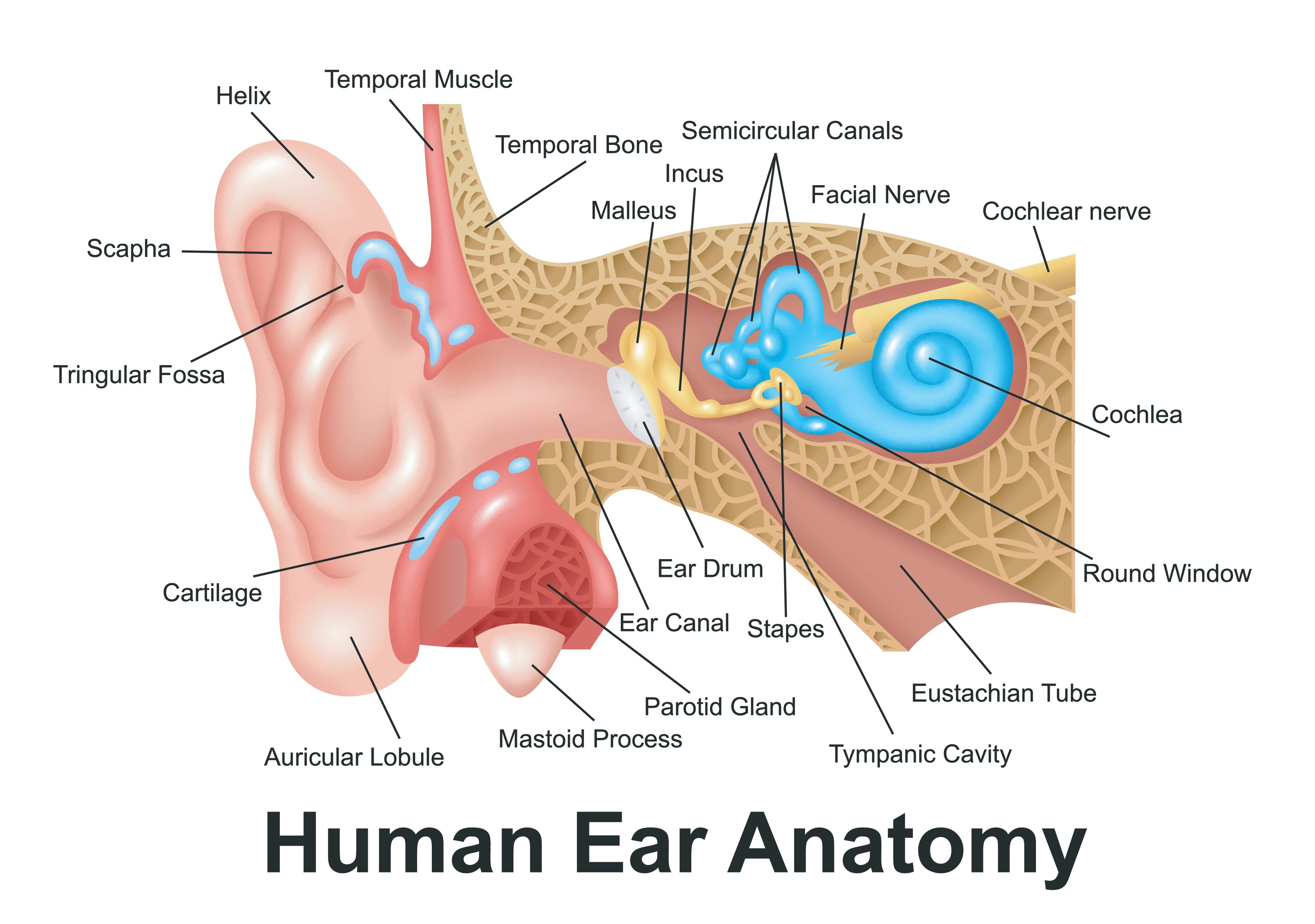- Children with normal hearing in both ears generally perform better with auditory tasks and processing sound in their right ear up until puberty.
- Ears are completely individual just like fingerprints! Yahoo has even explored technology that could unlock a cell phone when held to the ear.
- Of the 206 bones in the human body, the six smallest are in your ears: three in the right and three in the left. Together, each three are about the size of a pencil eraser.
- The hearing organ, called the cochlea, has 16,000 microscopic hair cells called sterocilia.
- The unit used to measure loudness – the decibel - was named after Alexander Graham Bell, the inventor of the telephone.
- We turn the radio up when we drive on the highway and down when we are on side streets is due to the fact that those with normal hearing need sound levels to be nearly 10 decibels louder than background noise. This is referred to as the signal-to-noise ratio.
- Other than vision and proprioception (the ability to sense the orientation of your body in your environment), our primary organs of balance, known as the vestibular system, are located in the inner ear. There are three semi-circular, bony rings located on different levels which contain fluid that moves as we move.
- Ears are self-cleaning. Only the outer third of the ear canal produces ear wax (cerumen), which moves outward on tiny hairs as we move our lower jaw to talk or eat.
- Thunder is the sound accompanied by lightning, but often there is a delay between when we see lightning and hear the thunder. That’s because sound travels nearly 760 mph whereas light travels about 186,000 mph. This is why we see lightning before we hear thunder.
- The best way to measure the distance of lightning from your location is by counting the seconds (one Mississippi, two Mississippi…) between the lightning and thunder. For every five seconds you count, the storm is about one mile away.
10 Interesting Facts about Ears & Hearing
Tags: Hearing
Great Apps to Practice Speech Sounds with Your Tween
Learning and practicing how to correctly produce their “r” or “s” sound is certainly NOT what 8-12-year-olds want to be doing! Most would prefer to be playing video games or riding their bike. One way to make speech therapy and at-home practice a little easier is to use an app. These apps could be on the parent’s phone, the tween’s phone, or a family iPad.
Tags: Speech, Language, Communication, Teens, Stuttering, Learning, Voice, talking
Why I Chose to Learn American Sign Language
Caring. Compassionate. Funny. Loves God. Can’t wait until Fall when Starbucks comes out with their signature Pumpkin Spice Latte with coconut milk. This person I’m describing is my sister, and she is deaf. She endured a terrible sickness at the age of 1 that took away her hearing, but not her spirit. My family and I wanted to know her – her thoughts, her needs, her dreams and goals. We needed to be able to communicate effectively with her. In order to achieve this, my parents decided that we would all learn American Sign Language (ASL). Many people assume learning a new language to communicate with a deaf person will be difficult – if not impossible. However, it is very possible to learn American Sign Language. Regardless of your age, if you are willing to learn, you will discover that your loved one holds all kinds of amazing ideas and plans for adventure. You and your loved one will thrive! Here are some tips to make learning American Sign Language more successful:
Tags: Language, Communication, Support, Deaf, Hard of Hearing, American Sign Language, ASL, Learning
12 Tips for Communicating with a Deaf Person
- Use a normal speaking pattern. Over-enunciating makes it hard for a Deaf person to read your lips.
- Write it down if necessary. Some people are better at reading lips than others
- Look directly at the person you are communicating with. If you look away, a Deaf person may miss what you are saying.
- Speak in a normal tone of voice. Since a Deaf person cannot hear you, raising your voice doesn’t help.
- Try to find your own way to communicate. Although you can’t talk to one another, there are many other ways for you to communicate. You can use a pen and paper or even text to have a conversation.
- Don’t be afraid to ask a Deaf person to repeat themselves. The goal is clear communication and understanding. Asking to repeat something has better results and less frustration – for both parties.
- Be patient and inclusive. Imagine you are trying to understand a conversation that you want to be involved in, but are unable due to the conversation’s speed, number of people talking at the same time, and/or not being able to share your ideas with the group. By allowing enough time and considering the communication needs of everyone in the group, you ensure that everyone can participate fully.
- In a group conversation, take turns speaking. A Deaf person can only look at one individual at a time.
- Be clear and concise. Saying “I’m fine” can have many different meanings with subtle differences. For example “I’m fine” can mean
- I feel well
- I feel the same way I always feel
- I’m way too busy to know how I feel
- Don’t bother me
- Did you want to know about my emotional or physical well-being?
- You don’t care how I feel or would have stopped walking to listen
- Use body language and gestures. Deaf and hard of hearing people who use sign language are accustomed to using their hands and face to communicate. Gesturing and using clear facial expressions when speaking to a person with hearing challenges can help them understand what you’re saying. “Miming” is also acceptable if it helps to get a certain point across, but remember that mime is not the same as sign language.
- Accept that awkward moments happen. Even if you follow all of the above tips while speaking to a Deaf or hard of hearing person, they’ll probably still misunderstand you at some point. Don’t feel bad or stop. Just repeat yourself and continue the conversation. If they’re having trouble understanding a certain word or phrase, try using a different word, rephrasing what you said, or typing it on your phone.
- Resist the urge to give up when misunderstandings happen. A little effort on your part can make a big difference to someone, and chances are that you’ll benefit from the experience, too.
Tags: Language, Communication, Deaf, Hard of Hearing, American Sign Language, ASL
My Child Needs Tubes in His Ears - What Does That Mean?
Did you know the most frequent pediatrician visits, other than for well-child care, are for ear problems? And, did you know that the most common surgery performed on children in the U.S. is for “tubes in the ears,” which refers to Tympanostomy tube (myringotomy with pressure equalization – “PE tube”) placement is the most common surgery performed on children in the United States
Tags: Hearing, Hearing Loss, toddler
Teaching Your Toddler How to Talk Effectively
Children learn how to talk by imitating others. They mimic what they hear, so it’s important for you to practice speaking with your child every day. Some words to focus on include nouns, verbs, adjectives and prepositions, which can be applied to daily activities. For example, if you are blowing bubbles with your child, you can emphasize:
Tags: Speech, Language, Communication, Learning, toddler, talking
How to Build Joint Attention Skills in Young Children with Autism
Joint attention is the ability to shift your attention between an object or event and your communication partner. For example, if a little girl notices an ice cream truck coming down the street, she may look at it, then turn to her father with a hopeful smile before turning back to stare at the ice cream truck. Or, a little boy may be spinning an empty water bottle on the floor, enjoying the movement and shifting colors as the bottle spins. He may look up at his mother and point to the bottle, sharing his enjoyment with her.
Tags: Language, Communication, Learning, talking, Autism
Common Communication Difficulties of Stroke Survivors
Suffering from a stroke can be a scary and challenging experience, causing brain damage that may lead to communication difficulties with language, speech, voice, cognition and even swallowing.
Tags: Speech, Language, Communication, Stroke, Voice
Benefits of Accent Modification in the Work Place
- Do you miss out on career advancement opportunities because of your accent?
- Do people often ask you to repeat yourself?
- Do you avoid speaking in English because you are afraid to make mistakes?
- Do you struggle to communicate at parties or social events?
Regardless of your native language, an accent can make it harder for others to understand you and cause frustration. An accent modification program can reduce communication breakdowns, enhancing both your clarity and confidence.
Tags: Speech, Language, Communication
Make Book Reading Interactive
Reading books with your preschooler is one of the best ways to increase language and pre-literacy skills. Language skills include listening (comprehending or understanding of concepts) and speaking (expressing thoughts, ideas, concepts, and feelings). Pre-literacy skills are those behaviors associated with successful reading development and include strong vocabulary and narrative skills, interest in books, print awareness, and phonological awareness. Some phonological awareness tasks for a preschool-aged child are rhyming, segmenting and blending syllables into words, and identifying beginning and ending sounds in words.
Tags: Speech, Language, Communication, Learning













